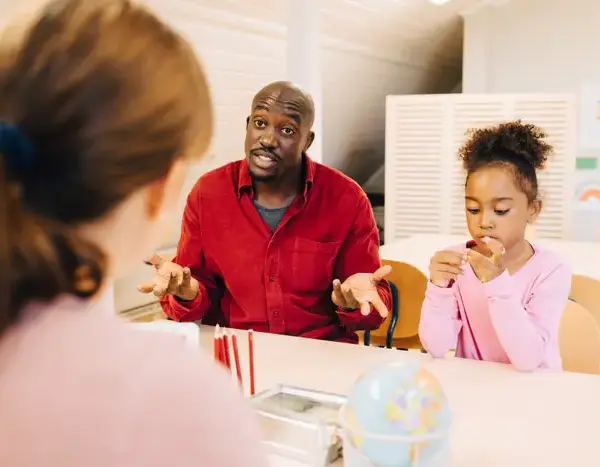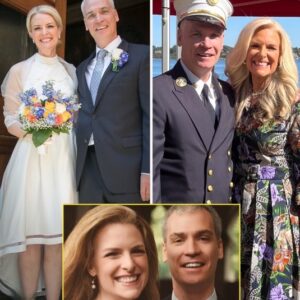The classroom had been buzzing with restless energy from the moment the morning bell rang.
Backpacks lay half-open on desks, pencils clattered loudly, and whispers bounced off the walls like echoes trapped in a small canyon.
The teacher, distracted and half-amused by the students’ chatter, leaned against her desk with a light laugh, barely trying to settle the chaos.
The room felt alive — but not in the warm, comforting way a classroom should. Underneath the noise lurked something sharper… something unkind. At the center of it all sat John.
He kept his eyes trained on the corner of his textbook, his shoulders hunched, trying desperately to shrink into himself. His throat tightened as he fought back the tears already pooling in his eyes.
A few students snickered. Someone whispered something cruel under their breath. Another pointed at him, laughing, unaware — or uncaring — of how deeply their words cut.

John clutched the edge of his desk. His breathing quickened. His vision blurred. He wanted to disappear.
And then — everything changed. The door to the classroom swung open with a gentle but unmistakably authoritative push. The sound wasn’t loud, but it sliced through the room with quiet power.
Every conversation stopped. Chairs froze mid-rock. Even the teacher straightened up, blinking rapidly as if waking from a dream.
A tall man stood framed in the doorway.
His presence was calm… yet commanding. He wasn’t dressed in expensive clothes — just a neat shirt, well-worn jacket, and sturdy shoes that spoke of a man who worked with his hands.
But there was something about him that radiated confidence, something that made every child sit up a little straighter without being told.
He stepped inside slowly, each footstep deliberate, his gaze steady and observant. The room fell completely silent.
John looked up, his breath catching in his chest. Recognition flickered in his eyes.
The man smiled warmly at his son — a soft, reassuring smile that melted away John’s fear in an instant.
The man turned to the rest of the room and spoke in a voice both gentle and solid:
“Hello, everyone. My name is Mr. Thomson… and I am John’s father.”
A collective gasp rippled through the students. Even the teacher’s eyebrows shot up in surprise. No one had expected this.

Mr. Thomson continued walking toward the front of the classroom, not hurriedly, but with the quiet assurance of someone who knew exactly why he was there.
“I understand,” he said, turning to face the students, “that my son was put in a difficult situation today.”
He didn’t raise his voice. He didn’t need to. Every word settled heavily in the air, impossible to ignore.
The students stared at him, wide-eyed. The teacher shuffled awkwardly, guilt pouring into her expression.
“But before we continue,” he said, “I want to share something important with you all.”
He paused — not dramatically, but thoughtfully — as though he truly cared whether his message would reach their hearts.
“You see,” he began, “I don’t have what many people call a ‘normal job.’ I’m not a lawyer, a doctor, or an office worker. I don’t wear suits or carry a briefcase. And because of that, some people assume things about me — and sometimes those assumptions reach my son.”
He glanced at John, who now sat a little taller.
“What I am,” Mr. Thomson continued, “is an inventor.”
The room erupted into whispers.
“An INVENTOR?”
“Like… real inventions?”
“Does he build robots?”
The teacher opened her mouth, perhaps to restore order, but the look Mr. Thomson gave the room was enough — they fell silent again almost instantly.
“Yes,” he said with a smile. “A real inventor. I create things that don’t exist yet. Things the world doesn’t have… but might desperately need.

My job doesn’t come with a uniform or a title printed on a shiny door. It comes with imagination, trial and error, dedication… and a lot of passion.”
He gestured gently toward his son.
“And John has been helping me for years. He’s not just a child who watches — he’s my partner. My co-inventor.”
John’s eyes widened, tears now replaced by pride.
“We are working on something together,” his father continued. “Something that could help millions of people. It’s a device that converts polluted air into clean, breathable oxygen.
It’s still a work in progress, but imagine what that could mean for cities with smog, for people struggling to breathe, for our planet.”
The classroom seemed to glow with newfound wonder.
Even the teacher, who earlier had nudged the laughter along, now stood frozen, ashamed, staring at the floor.
“Every family is different,” Mr. Thomson said softly. “Every path is different. But no one deserves to be mocked for who they are — especially a child. Especially my son.”
His voice grew firmer, though never unkind.
“You might not understand someone’s life from the outside. You may not see their journey, their struggles, their dreams. But respect,” he said, “is something we owe each other. Always.”
He turned to John and offered a small nod — one filled with love, assurance, and pride.
John straightened fully, his chin lifted. The child who had moments ago been crying… now looked stronger than anyone else in the room.
Mr. Thomson began walking toward the door, but paused one last time.
“Remember,” he said, “kindness is not weakness. It is strength. And curiosity about others is far better than judgment of them.”
Then he stepped out of the classroom.
For several seconds, the room remained perfectly still.
Then — slowly — every student looked at John in a new way. Not with ridicule. Not with amusement. But with admiration, curiosity… and respect.

The boy they once teased had become someone remarkable in their eyes.
From that day forward, everything changed. The laughter in the hallways softened.
The conversations became kinder. And John walked through school not as a child hiding from shame, but as someone who finally understood his worth — and inspired others to understand theirs.
Because sometimes, it only takes one moment —
one voice,
one truth,
one parent stepping forward —
to change the entire trajectory of a child’s world.
The classroom had been buzzing with restless energy from the moment the morning bell rang.
Backpacks lay half-open on desks, pencils clattered loudly, and whispers bounced off the walls like echoes trapped in a small canyon.
The teacher, distracted and half-amused by the students’ chatter, leaned against her desk with a light laugh, barely trying to settle the chaos.
The room felt alive — but not in the warm, comforting way a classroom should. Underneath the noise lurked something sharper… something unkind. At the center of it all sat John.
He kept his eyes trained on the corner of his textbook, his shoulders hunched, trying desperately to shrink into himself. His throat tightened as he fought back the tears already pooling in his eyes.
A few students snickered. Someone whispered something cruel under their breath. Another pointed at him, laughing, unaware — or uncaring — of how deeply their words cut.

John clutched the edge of his desk. His breathing quickened. His vision blurred. He wanted to disappear.
And then — everything changed. The door to the classroom swung open with a gentle but unmistakably authoritative push. The sound wasn’t loud, but it sliced through the room with quiet power.
Every conversation stopped. Chairs froze mid-rock. Even the teacher straightened up, blinking rapidly as if waking from a dream.
A tall man stood framed in the doorway.
His presence was calm… yet commanding. He wasn’t dressed in expensive clothes — just a neat shirt, well-worn jacket, and sturdy shoes that spoke of a man who worked with his hands.
But there was something about him that radiated confidence, something that made every child sit up a little straighter without being told.
He stepped inside slowly, each footstep deliberate, his gaze steady and observant. The room fell completely silent.
John looked up, his breath catching in his chest. Recognition flickered in his eyes.
The man smiled warmly at his son — a soft, reassuring smile that melted away John’s fear in an instant.
The man turned to the rest of the room and spoke in a voice both gentle and solid:
“Hello, everyone. My name is Mr. Thomson… and I am John’s father.”
A collective gasp rippled through the students. Even the teacher’s eyebrows shot up in surprise. No one had expected this.

Mr. Thomson continued walking toward the front of the classroom, not hurriedly, but with the quiet assurance of someone who knew exactly why he was there.
“I understand,” he said, turning to face the students, “that my son was put in a difficult situation today.”
He didn’t raise his voice. He didn’t need to. Every word settled heavily in the air, impossible to ignore.
The students stared at him, wide-eyed. The teacher shuffled awkwardly, guilt pouring into her expression.
“But before we continue,” he said, “I want to share something important with you all.”
He paused — not dramatically, but thoughtfully — as though he truly cared whether his message would reach their hearts.
“You see,” he began, “I don’t have what many people call a ‘normal job.’ I’m not a lawyer, a doctor, or an office worker. I don’t wear suits or carry a briefcase. And because of that, some people assume things about me — and sometimes those assumptions reach my son.”
He glanced at John, who now sat a little taller.
“What I am,” Mr. Thomson continued, “is an inventor.”
The room erupted into whispers.
“An INVENTOR?”
“Like… real inventions?”
“Does he build robots?”
The teacher opened her mouth, perhaps to restore order, but the look Mr. Thomson gave the room was enough — they fell silent again almost instantly.
“Yes,” he said with a smile. “A real inventor. I create things that don’t exist yet. Things the world doesn’t have… but might desperately need.

My job doesn’t come with a uniform or a title printed on a shiny door. It comes with imagination, trial and error, dedication… and a lot of passion.”
He gestured gently toward his son.
“And John has been helping me for years. He’s not just a child who watches — he’s my partner. My co-inventor.”
John’s eyes widened, tears now replaced by pride.
“We are working on something together,” his father continued. “Something that could help millions of people. It’s a device that converts polluted air into clean, breathable oxygen.
It’s still a work in progress, but imagine what that could mean for cities with smog, for people struggling to breathe, for our planet.”
The classroom seemed to glow with newfound wonder.
Even the teacher, who earlier had nudged the laughter along, now stood frozen, ashamed, staring at the floor.
“Every family is different,” Mr. Thomson said softly. “Every path is different. But no one deserves to be mocked for who they are — especially a child. Especially my son.”
His voice grew firmer, though never unkind.
“You might not understand someone’s life from the outside. You may not see their journey, their struggles, their dreams. But respect,” he said, “is something we owe each other. Always.”
He turned to John and offered a small nod — one filled with love, assurance, and pride.
John straightened fully, his chin lifted. The child who had moments ago been crying… now looked stronger than anyone else in the room.
Mr. Thomson began walking toward the door, but paused one last time.
“Remember,” he said, “kindness is not weakness. It is strength. And curiosity about others is far better than judgment of them.”
Then he stepped out of the classroom.
For several seconds, the room remained perfectly still.
Then — slowly — every student looked at John in a new way. Not with ridicule. Not with amusement. But with admiration, curiosity… and respect.

The boy they once teased had become someone remarkable in their eyes.
From that day forward, everything changed. The laughter in the hallways softened.
The conversations became kinder. And John walked through school not as a child hiding from shame, but as someone who finally understood his worth — and inspired others to understand theirs.
Because sometimes, it only takes one moment —
one voice,
one truth,
one parent stepping forward —
to change the entire trajectory of a child’s world.





